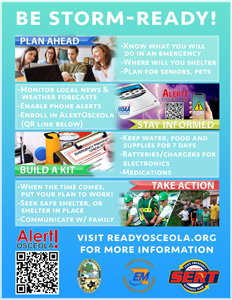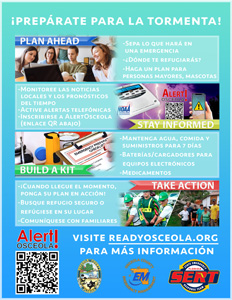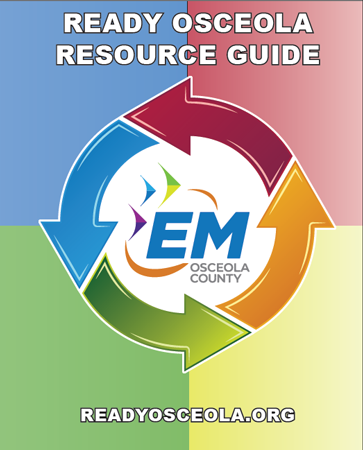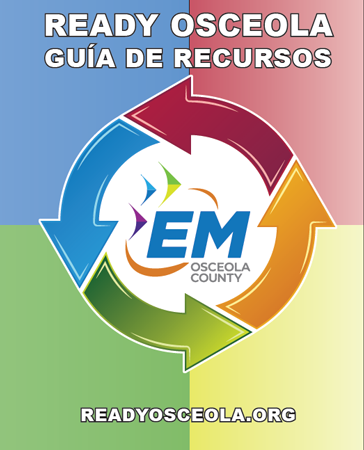Emergency Management Preparation
Disasters can and usually happen without warning. Osceola County is exposed to many hazards, both natural and man-made. Hurricanes, wildfires, tornadoes, power outages, and acts of terrorism are just some of the potential emergencies we may encounter. Please use the below guides to help your family be better prepared for potential disasters.
Ready Osceola Resource Guide
For information on everything from NOAA weather radios to having a family disaster plan and what supplies to always have on hand, this is booklet is full of potentially life-saving information.
Make a Family Plan
Make a plan today. Your family may not be together if a disaster strikes, so it is important to know which types of disasters could affect your area. Learn more about creating a Family Plan at FloridaDisaster.org.
Mitigation
Mitigation is the process of lessening the impact of disasters. For example, if your home was built before current codes and standards, you can strengthen the walls or roof to make them more resilient to disasters. Another example is to take steps to prevent flooding damage before a flood happens.
Taking action to reduce risks and minimize damage is typically more cost-effective than dealing with the consequences of a disaster. While temporary measures may be necessary during a crisis, long-term mitigation is essential.
FloridaDisaster.org - Mitigation
Phone Tips
- Develop a plan for how you will communicate with loved ones after a disaster.
- Identify an out-of-state contact--long distance phone lines often work before local phone lines are restored, so using an out-of-state contact is a good idea. Provide this person with the contact information of people you want to keep informed of your situation.
- Have everyone in your family check-in with the out-of-state contact as soon as possible after disaster strikes.
- Avoid making non-urgent phone calls after a disaster - even if phone lines are un-damaged, increased phone traffic can jam phone circuits.
- Don't count on your cell phone - increased traffic on cell phone networks can quickly overload wireless capacity. Record an outgoing message on your voicemail so that callers can be re-assured of your safety status.
- Have a backup phone that does not require electricity – cordless phones require electricity, so make sure you have at least one phone that requires no electricity (uses cord connection to operate).
Emergency Food & Water
Even though it is unlikely that an emergency would cut off food supply for two weeks, consider maintaining a supply that will last that long.
You may not need to go out and buy foods to prepare an emergency food supply. You can use canned goods, dry mixes, and other staples already in your cupboard. Be sure to check expiration dates and follow the practice of first-in, first-out.
Having an ample supply of clean water is a top priority in an emergency. A normally active person needs to drink at least two quarts (half gallon) of water each day. People in hot environments, children, nursing mothers, and ill people will require even more.
You will also need water for food preparation and hygiene. Store at least one gallon per person, per day. Consider storing at least a two-week supply of water for each member of your family. If you are unable to store this quantity, store as much as you can.
Read more on the attached "FEMA - Food and Water in an Emergency" document.
Wildfire Preparation
Wildfires often begin unnoticed. They can spread quickly, igniting brush, trees and homes. Reduce your risk by preparing now, before wildfire strikes. Meet with your family to decide what to do and where to go if wildfires threaten your area.
Conditions That Cause Wildfires
Prolonged drought can cause tender plants to die and dry out, creating fuel for wildfires.
Cold weather, particularly during drought, speeds the dying and drying process.
Thunderstorms bring only limited relief when the woods are dry. Plants and trees dry again quickly, leaving potential for wildfire.
Wind dries plants and trees, and can cause fires to spread.
Burning on windy days increases the potential for wildfire.
Simply Ways to Protect Your Home and Family
- Regularly clean roof and gutters.
- Inspect chimneys at least twice a year. Keep the dampers in good working order. Equip chimneys and stovepipes with a spark arrester that meets the requirements of National Fire Protection Association Code 211.
- Use 1/2" inch mesh screen beneath porches, decks, floor areas and the home itself. Screen openings to floors, roof and attic.
- Install a smoke detector on each level of your home, especially near bedrooms. Test the smoke detectors monthly and change the batteries two times a year. A helpful reminder is to change the batteries when the time changes in the spring and fall.
- Make sure your home has an ABC type fire extinguisher. Teach everyone in your family how to use the fire extinguisher, and show them where it is kept.
- Have a ladder on hand that will reach the roof.
- Consider installing protective shutters or heavy fire-resistant drapes.
- Keep handy household items like a rake, axe, handsaw or chainsaw, bucket and shovel that can be used as fire fighting tools.
- Have a garden hoses on outside taps that are long enough to reach any area of the home and other structures on the property. Equip garden hoses with spray-gun nozzles.
- Know where fuel supply shut off valve is. Normally they are at the tank or meter. Check with your fuel supply company.
- Make sure you have a portable radio and backup batteries.
Family Disaster Plan for Wildfires
- Meet with your family now to decide what to do and where to go if wildfire threatens your home.
- Place emergency phone numbers by the phone. Include your local fire station’s phone number.
- Decide where you will go and how you will get there if you have to evacuate. With fire, you may have only a moment’s notice to evacuate. When practical, plan at least 2 escape routes out of your home and out of your neighborhood.
- Keep firefighting tools handy. Items to include are a shovel, rake, axe, handsaw or chainsaw, and a 2-gallon bucket.
- Have a plan for your pets.
- Practice family fire drills.
- Identify a family meeting place in case all members of the family aren’t home when an evacuation takes place.
- Make sure your children understand what to do if a fire threatens.
Training
You can make a difference in the outcome of a disastrous situation. Regardless of the threat, you can become informed and make decisions based on the combined experiences offered here.
There are key elements you should know about emergencies and disaster, and how to prepare yourself when threatened. Remember you and your family are at stake here, so take make the time to become better aware of the steps you can take. Below are a list of links of partner organizations that can assist in the training process:
The Office of Emergency Management offers a variety of training for groups and organizations. We also provide speakers for your group or organization. Please give us a call and let us know what you are looking for! 407-742-9000.





